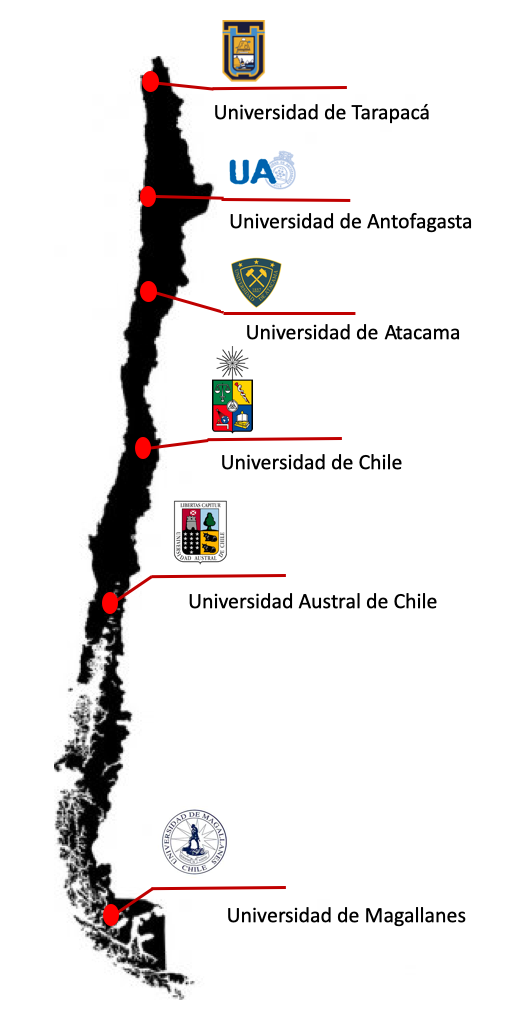Study of genetic variation at the whole genome scale for the susceptibility and severity of COVID-19 in the Chilean population
Abstract
50% of the differences in symptoms and severity of the COVID-19 would be associated with genetic variation. Differences in allele frequencies of genes that mediate infection and clinical course of the disease have been reported among populations throughout the world. From north to south, the Chilean population is heterogeneous in its ancestry. We hypothesized that this variation could have effects on the biological processes underlying the symptomatology and clinical evolution associated with Sars-Cov-2 infection. We propose a genomic mapping of the genetic variation associated with COVID-19 susceptibility and severity. Positive cases from the country will be invited to participate through the referral centers and through public announcements and their informed consent and clinical information will be electronically captured. A center with a SLB-2 laboratory per macrozone will be in charge of receiving samples and extracting human DNA, which will be genotyped by microarrays (N = 4000). The database generated will have national scope and will be public for aggregate data. The project is part of the international initiative for the COVID-19 Host Genetics study (covid19hg.org). The results will make it possible to stratify the population by risk and identify potential therapeutic targets.
Objetives
Course objective: Identify and map the genetic variation associated with the susceptibility to presenting symptoms of the COVID-19 disease and its severity.
Specific objective 1: Recruit 5000 cases of the COVID-19 disease, distributed in the five macrozones of Chile (extreme north, north, center, south and southern).
Specific objective 2: Characterize the phenotypic variation related to the diversity of symptoms and severity of the disease presented by COVID-19 cases in relation to non-genetic risk factors and viral load.
Specific objective 3: Genotyping the genomes of 4,000 cases of COVID-19 disease and associating their ancestry with the phenotypic variation of disease severity.
Specific objective 4: Identify predictive genetic variants of phenotypic variation and the degree of severity carried out through association studies.
Problem to analize
A variability in the manifestation of symptomatic phenotypes of severity due to COVID-19 has been reported worldwide. COVID-19 is mild or moderate in 80% of cases, 15% require hospital admission, 5% intensive care, and 4% die [1–3]. However, this distribution, as well as the symptoms, varies significantly between countries. 50% of the differences in COVID-19 symptoms would be associated with genetic variation [4], with differences in the allele frequencies of genes that mediate viral infection among populations around the world [5]. From north to south, the Chilean population is heterogeneous in terms of its genetic makeup, due to differences in its ancestral components and recent immigration from other regions of Latin America [6,7]. Problem to be addressed: different segments of the population may have a higher or lower risk of presenting severe forms of the disease, as well as being infected by Sars-Cov-2. Hypothesis: There is genetic variation underlying the differences in susceptibility and phenotypic manifestations of COVID-19. This variation would be associated with ancestral components in Chilean genomes and can be detected through a complete genome study.
|
|
Researchers
|
Funding
Project funded by ANID Grant COVID19-0961, The Broad Institute and FIMM.
References
- European Centre for Disease Prevention and Control (ECDC). Case fatality rate of COVID-19 (%) (Only observations with ≥100 cases). Available: https://ourworldindata.org/mortality-risk-covid#the-case-fatality-rate
- European Center for Disease Control and Prevention. Coronavirus disease 2019 (COVID-19) pandemic: increased transmission in the EU/EEA and the UK – seventh update. 2020. Available: https://www.ecdc.europa.eu/sites/default/files/documents/RRA-seventh-update-Outbreak-of-coronavirus-disease-COVID-19.pdf
- World health Organization. Report of the WHO-China Joint Mission on Coronavirus Disease 2019 (COVID-19). 2020. Available: https://www.who.int/docs/defaultsource/coronaviruse/who-china-joint-mission-on-covid-19-final-report.pdf
- Williams FM, Freydin M, Mangino M, Couvreur S, Visconti A, Bowyer RC, et al. Self-reported symptoms of covid-19 including symptoms most predictive of SARS-CoV-2 infection, are heritable. medRxiv. 2020; 2020.04.22.20072124. doi:10.1101/2020.04.22.20072124
- Cao Y, Li L, Feng Z, Wan S, Huang P, Sun X, et al. Comparative genetic analysis of the novel coronavirus (2019-nCoV/SARS-CoV-2) receptor ACE2 in different populations. Cell Discov. 2020;6: 1–4. doi:10.1038/s41421-020-0147-1
- Eyheramendy S, Martinez FI, Manevy F, Vial C, Repetto GM. Genetic structure characterization of Chileans reflects historical immigration patterns. Nat Commun. 2015;6: 6472. doi:10.1038/ncomms7472
- Verdugo RA, Di Genova A, Herrera L, Moraga M, Acuña M, Berríos S, et al. Development of a small panel of SNPs to infer ancestry in Chileans that distinguishes Aymara and Mapuche components. Biol Res. 2020;53: 15. doi:10.1186/s40659-020-00284-5


